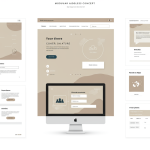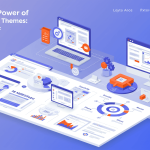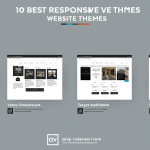
As the digital landscape continues to evolve, website themes play a critical role in shaping user perceptions, driving conversions, and supporting brand identity. However, in 2024 and beyond, simply delivering visually appealing layouts is not enough. Modern website themes must also prioritize performance, accessibility, and sustainability. Performance affects user engagement and SEO rankings—slow designs frustrate visitors and lower search visibility. Accessibility ensures that sites can be used by all individuals, including those with disabilities, complying with WCAG 2.1 standards and widening your audience. Meanwhile, sustainable design practices reduce energy consumption and carbon footprint, reflecting corporate responsibility in an increasingly eco-conscious market.
Why Performance Matters in Modern Website Themes

Speed has become a critical differentiator in user experience and search engine ranking. A fast-loading website theme not only retains visitors but also improves SEO performance. According to industry studies, pages that load within two seconds have a significantly lower bounce rate compared to slower pages. For businesses and individuals alike, optimizing theme performance translates into higher engagement, better conversion rates, and reduced infrastructure costs. Learn more about 10 Best Responsive Website Themes.
- Minified CSS and JavaScript: Remove unnecessary characters and whitespace to reduce file size.
- Selective Asset Loading: Implement lazy loading for images and defer non-critical scripts.
- Efficient Font Management: Choose modern font formats like WOFF2 and host fonts locally or via a fast CDN.
- Optimized Media: Use responsive image attributes, modern formats such as WebP, and adaptive compression techniques.
By integrating these techniques into your theme’s core, you’ll deliver a snappy experience that impresses users and meets Google’s Core Web Vitals requirements.
Implementing Accessible Design Principles
Accessibility ensures that your website themes can be used effectively by everyone, including people with disabilities. Meeting WCAG 2.1 standards not only widens your audience but also helps avoid legal issues related to non-compliance.
- Semantic HTML: Use proper heading levels, landmarks, and ARIA roles to convey content structure.
- Keyboard Navigation: Ensure all interactive elements are reachable and operable via keyboard.
- Color Contrast: Maintain sufficient contrast between text and background according to WCAG guidelines.
- Text Alternatives: Provide alt text for images and captions for multimedia content.
- Focus Indicators: Design visible and intuitive focus states for links and form controls.
Embedding accessibility checks into your development workflow—using automated tools and manual testing with assistive technologies—will lead to a more inclusive user experience.
Adopting Sustainable Web Practices
As global internet usage grows, the environmental impact of digital infrastructure becomes more significant. Sustainable web design aims to minimize energy consumption and carbon emissions associated with serving your website themes.
- Lightweight Code: Reduce page weight by eliminating unnecessary dependencies and assets.
- Green Hosting: Choose hosting providers powered by renewable energy or carbon-offset programs.
- Efficient Caching: Implement server-side and browser caching strategies to reduce repeated network requests.
- Resource Prioritization: Load critical content first and defer or lazy-load non-essential elements.
- Monitoring Metrics: Track data transfer volumes and server load to identify optimization opportunities.
By focusing on sustainable practices, you not only lower hosting costs but also demonstrate environmental responsibility to your audience.
Key Features of Next-Gen Website Themes
- Responsive and Adaptive Layouts: Ensure seamless display across devices and screen sizes using fluid grids and flexible components.
- Dark Mode Compatibility: Provide alternative color schemes that reduce eye strain and support power saving on OLED screens.
- Customizable Design Tokens: Expose variables for colors, typography, and spacing to simplify theming and brand alignment.
- Built-In SEO Components: Include schema markup templates, meta tag management, and optimized heading structures out of the box.
- Integration-Ready Architecture: Offer hooks or APIs for popular CMS platforms, static site generators, or headless systems.
- Modular Component Library: Package reusable UI elements—buttons, cards, sliders—in an accessible and isolated manner.
Incorporating these features ensures your theme remains relevant, adaptable, and easy to maintain as web standards evolve.
Building Modular and Flexible Theme Structures
Modularity allows developers to load or customize only the parts they need, reducing bloat and improving maintainability. A flexible theme structure typically follows these principles:
- Component-Based Organization: Separate UI elements into dedicated directories with clear naming conventions.
- Configuration Files: Centralize theme settings—colors, fonts, layout options—in easily editable files or JSON objects.
- Scoped Styles: Use CSS Modules, BEM methodology, or CSS-in-JS to prevent style collisions and ensure predictability.
- Plugin System: Design hooks and extension points for easy feature enhancements without modifying core code.
- Version Control and Changelogs: Maintain a documented release process to track updates, deprecations, and bug fixes.
By prioritizing modularity and clarity in your theme architecture, you empower teams to collaborate efficiently and reduce technical debt over time.
Integrating SEO and Performance Optimization

An effective theme balances search engine requirements with speed enhancements. Beyond fast load times, SEO-friendly themes include features that help content rank higher:
- Clean URL Structures: Generate human-readable and keyword-rich permalinks automatically.
- Lazy Loading Above the Fold: Prioritize visible content and defer secondary assets.
- Structured Data: Embed JSON-LD snippets for articles, breadcrumbs, and organization markup.
- Local TTFB Improvement: Optimize server response times through caching and CDN integration.
- Automated Sitemap and Robots.txt: Provide tools to generate and update sitemaps and robots directives seamlessly.
Combining SEO best practices with performance tactics ensures your theme not only looks great but also drives organic traffic.
A Step-by-Step Workflow for Theme Development
Adopting a structured workflow helps you deliver high-quality website themes on time and within budget. Here’s a recommended process:
- Requirement Gathering: Define goals, target audience, and technical constraints.
- Design Prototype: Create UI mockups with Figma, Sketch, or similar tools, focusing on layout, typography, and color schemes.
- Development Setup: Initialize a project scaffold using a modern toolchain like Webpack, Vite, or Gulp.
- Core Implementation: Code base styles, components, and layout templates according to your modular structure.
- Performance Auditing: Use Lighthouse, WebPageTest, or GTmetrix to identify bottlenecks and apply optimizations.
- Accessibility Testing: Run automated audits with Axe or Lighthouse and conduct manual tests with screen readers.
- Cross-Browser QA: Verify theme functionality across major browsers and devices.
- Documentation: Write clear usage guides, configuration instructions, and code examples.
- Release and Distribution: Publish to npm, theme marketplaces, or your CMS’s repository with version tagging.
Following these steps fosters consistency, reduces errors, and accelerates the time to market.
Testing, Deployment, and Ongoing Maintenance
Launching your theme is just the beginning. Proper testing, deployment strategies, and maintenance routines ensure long-term success:
- Continuous Integration: Set up CI pipelines to run linting, unit tests, and build tasks automatically.
- Staging Environments: Deploy preview sites for stakeholder review and final QA approval.
- Versioned Releases: Use semantic versioning to communicate changes and maintain backward compatibility.
- Automated Backups: Ensure both theme code and site data are backed up before major updates.
- Performance Monitoring: Integrate real-user monitoring (RUM) and uptime checks to proactively address issues.
- User Feedback Loop: Collect feedback on design, usability, and performance to guide future improvements.
By embedding testing and maintenance into your development culture, you preserve user experience quality and avoid unexpected downtime.
Conclusion
In 2024, website themes must evolve beyond aesthetics to meet the demands of performance-conscious users, accessibility compliance, and environmental responsibility. By prioritizing speed, inclusive design, and sustainable practices—and by following a modular development approach and robust workflow—you can build themes that not only look stunning but also drive results and resonate with modern audiences.
Start applying these strategies today to craft next-generation website themes that excel in every critical metric. Your users will appreciate the fast load times, seamless accessibility, and eco-friendly approach—and search engines will reward your efforts with higher rankings. The future of web theming is fast, inclusive, and green. Are you ready?
















No Comments